-
The strong outlook for carbon pricing in the Western Balkans means that new lignite plants will be loss making.
2 GW of new lignite capacity is currently planned in the region. If built, these plants will generate a cumulative loss by 2040. This is because of low efficiency of lignite mining, costs to comply with air pollution regulation and limited export opportunities after establishment of the EU Carbon Border Adjustment Mechanism (CBAM). A phase-in of carbon pricing in Energy Community countries would further increase losses.
-
From an economic perspective, existing lignite units in the region should be closed by 2040.
A 2040 lignite exit increases system costs by 3–4 €/MWh in an unlikely scenario without carbon pricing. With the EU CBAM regime or any other form of domestic carbon pricing, closing lignite plants by 2040 lowers system costs.
-
The planned and gradual phase-out of lignite will ensure security of supply.
Security of supply is not an issue if the gradual phase-out of lignite is accompanied by a rapid scaling of renewables, enhanced interconnections, regional power market integration, strengthening of existing hydro-storage and targeted investments in flexible gas plants. Expanding renewables also reduces import dependency of the power and energy sectors.
-
A renewables-based power system is a ‘no regret’ strategy for the Western Balkans.
Replacing lignite generation by renewables lowers wholesale prices, hedges against carbon prices and avoids that fossil gas infrastructure will become stranded. Renewables deployment can largely be financed from market revenues, especially in case of carbon pricing. Renewables also come with many co-benefits such as improved air quality and new job opportunities. ‘Just transition’ policies would ensure that no one is left behind.
- Format
- Study
- Date
- 4 October 2021
The future of lignite in the Western Balkans
Scenarios for a 2040 lignite exit

Preface
In November 2020, the six Western Balkan countries signed the ‘Sofia Declaration’ committing themselves to climate-neutrality by 2050. The Green Agenda for the Western Balkans, adopted together with the Sofia Declaration, could pool 28 billion euros of investments to support the region’s economic recovery and long-term convergence with the EU, particularly by accelerating climate protection and the clean energy transition.
Climate-neutrality by 2050 cannot be achieved without a phasing out of lignite for power production. Still, most of the power sector in the Western Balkans is yet to act. Apart from North Macedonia, no other lignite-reliant country has publicly announced a phase-out. On the contrary: 2 GW of additional lignite capacity is planned in the region either with Chinese or unclear financing; generally, in conflict with state aid rules and air pollution limits. The absence of a CO₂ pricing mechanisms contributes to these developments. Without a change in direction, countries and taxpayers will soon face stranded assets and unserviceable loans, particularly because the EU’s Carbon Border Adjustment Mechanism will make the newly planned lignite units unprofitable.
To support the necessary debate on a lignite phase-out strategy for the Western Balkans, we have teamed up with enervis energy advisors and our regional think tank partners RESET from Bosnia and Herzegovina, INDEP from Kosovo and ASOR from Serbia to develop analytically robust scenarios for a lignite phase-out by 2040. The results are clear: countries in the region should align their climate and energy policies with the EU’s 2030 and 2050 targets! The EU Green Deal is an opportunity for these countries to initiate a deep decarbonization of their power systems based on renewable energies. Now is the moment for the Western Balkans to seize that chance.
Key findings
Bibliographical data
- Authors
- Rita Kunert, Julius Ecke, Christoph Pfister
- Publication number
- 225/04-S-2021/EN
- Version number
- 1.0
- Publication date
-
4 October 2021
- Pages
- 102
- Suggested citation
- enervis (2021): The Future of Lignite in the Western Balkans. Scenarios for a 2040 Lignite Exit. Study on behalf of Agora Energiewende.
- Project
- Produced within the framework of The future of lignite in the Western Balkans
Downloads
-
pdf 9 MB
The Future of Lignite in the Western Balkans
Scenarios for a 2040 Lignite Exit
All figures in this publication
2018 power mix of WB-6 countries
Figure 1 from The future of lignite in the Western Balkans on page 7

Under consideration of the Creative Commons license CC BY (attribution) the image may be further processed in any format or medium (also commercially, also in modified form), as long as the author is mentioned and a link to the license is given.
Scenario architecture
Figure 2 from The future of lignite in the Western Balkans on page 8
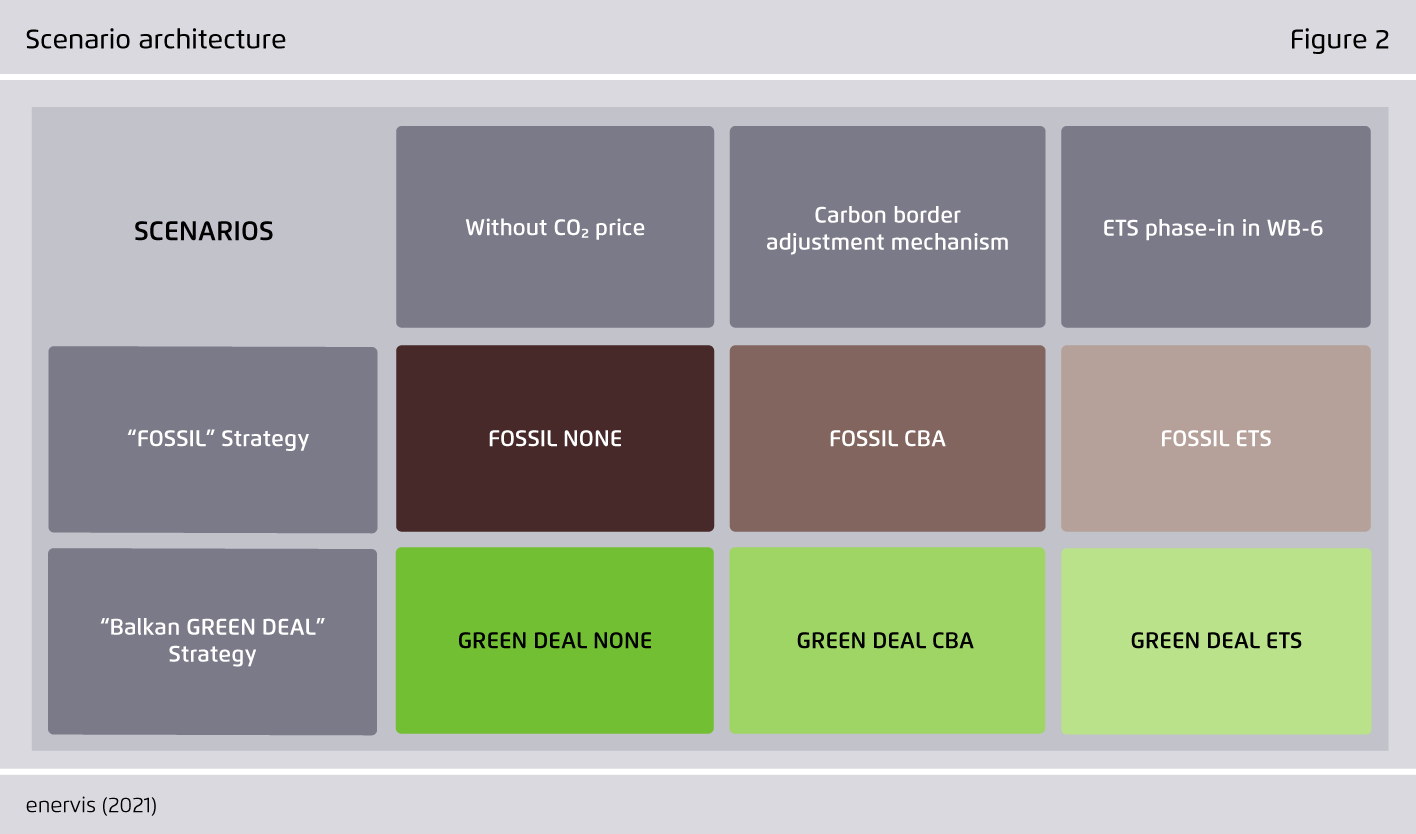
Under consideration of the Creative Commons license CC BY (attribution) the image may be further processed in any format or medium (also commercially, also in modified form), as long as the author is mentioned and a link to the license is given.
Calculated net present values for proposed lignite projects in the region
Figure 3 from The future of lignite in the Western Balkans on page 9
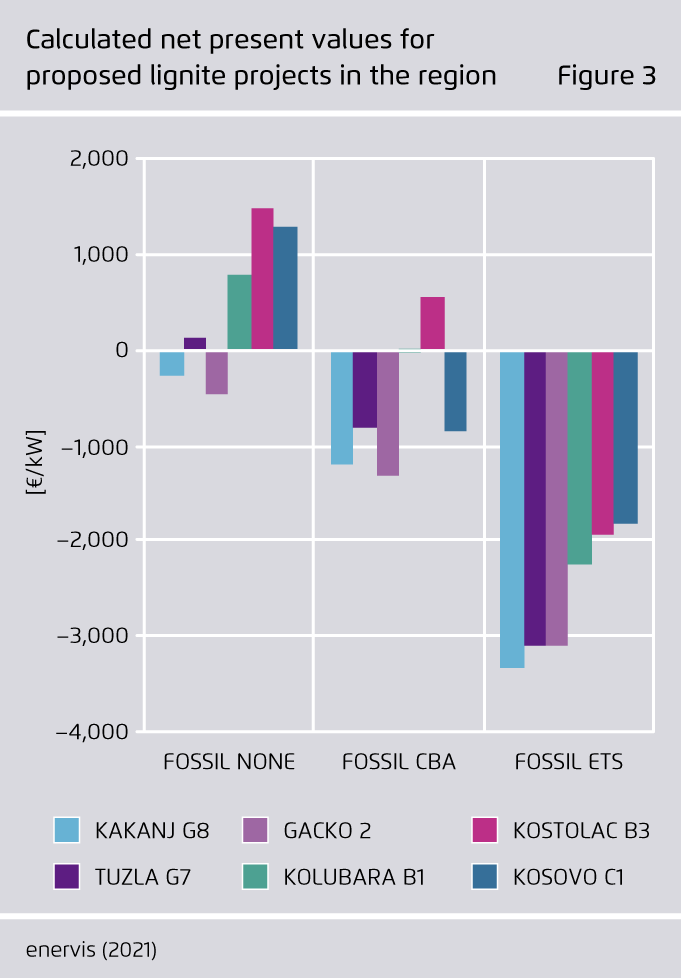
Under consideration of the Creative Commons license CC BY (attribution) the image may be further processed in any format or medium (also commercially, also in modified form), as long as the author is mentioned and a link to the license is given.
Cumulated (2020–2050) incremental generation costs in di fferent scenarios (Green Deal minus Fossil) for the WB-6 region
Figure 4 from The future of lignite in the Western Balkans on page 9

Under consideration of the Creative Commons license CC BY (attribution) the image may be further processed in any format or medium (also commercially, also in modified form), as long as the author is mentioned and a link to the license is given.
Total CO₂ emissions 2020–2050 for the WB-6 region
Figure 5 from The future of lignite in the Western Balkans on page 9

Under consideration of the Creative Commons license CC BY (attribution) the image may be further processed in any format or medium (also commercially, also in modified form), as long as the author is mentioned and a link to the license is given.
Annual RES support (lines) vs. RES system costs: Bosnia and Herzegovina, Serbia and Kosovo
Figure 6 from The future of lignite in the Western Balkans on page 10

Under consideration of the Creative Commons license CC BY (attribution) the image may be further processed in any format or medium (also commercially, also in modified form), as long as the author is mentioned and a link to the license is given.
Investment needs for the WB-6 region in each of the scenarios
Figure 7 from The future of lignite in the Western Balkans on page 11

Under consideration of the Creative Commons license CC BY (attribution) the image may be further processed in any format or medium (also commercially, also in modified form), as long as the author is mentioned and a link to the license is given.
Overview of coal exit policies across Europe
Figure 8 from The future of lignite in the Western Balkans on page 13

Under consideration of the Creative Commons license CC BY (attribution) the image may be further processed in any format or medium (also commercially, also in modified form), as long as the author is mentioned and a link to the license is given.
2018 power mix of WB-6 countries and ENTSO-E aggregate (relative terms)
Figure 9 from The future of lignite in the Western Balkans on page 19

Under consideration of the Creative Commons license CC BY (attribution) the image may be further processed in any format or medium (also commercially, also in modified form), as long as the author is mentioned and a link to the license is given.
2018 power mix of WB-6 countries in absolute numbers
Figure 10 from The future of lignite in the Western Balkans on page 20

Under consideration of the Creative Commons license CC BY (attribution) the image may be further processed in any format or medium (also commercially, also in modified form), as long as the author is mentioned and a link to the license is given.
2018 power trade balances of WB-6 countries
Figure 11 from The future of lignite in the Western Balkans on page 21

Under consideration of the Creative Commons license CC BY (attribution) the image may be further processed in any format or medium (also commercially, also in modified form), as long as the author is mentioned and a link to the license is given.
Distribution of WB-6 lignite fleet (capacity terms) by age cluster
Figure 12 from The future of lignite in the Western Balkans on page 21
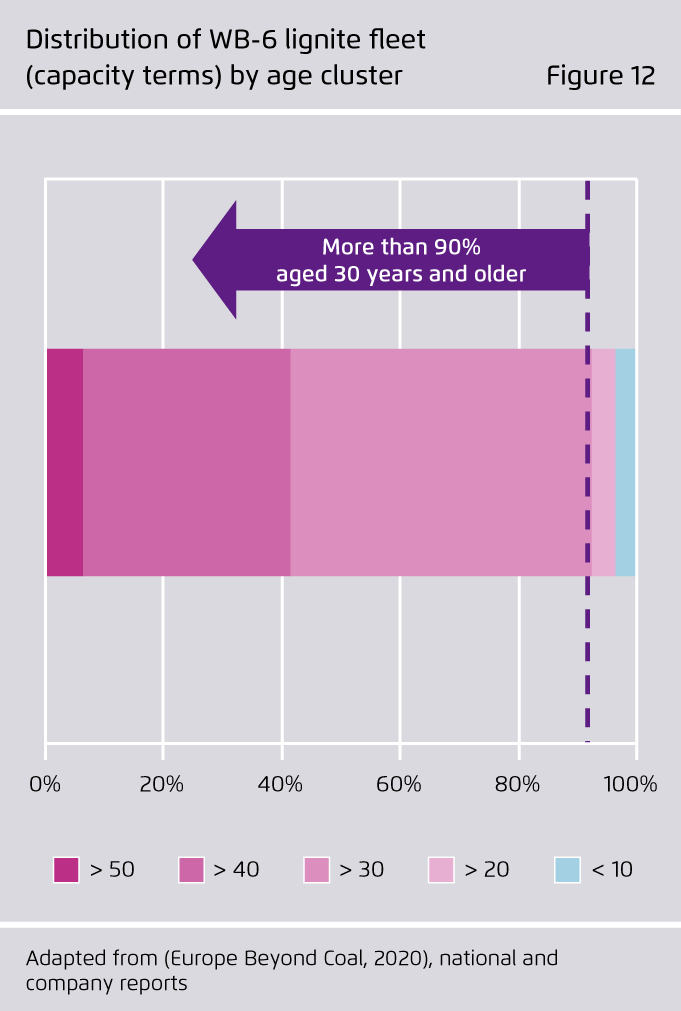
Under consideration of the Creative Commons license CC BY (attribution) the image may be further processed in any format or medium (also commercially, also in modified form), as long as the author is mentioned and a link to the license is given.
Breakdown of WB-6 lignite fleet by age cluster and country
Figure 13 from The future of lignite in the Western Balkans on page 22

Under consideration of the Creative Commons license CC BY (attribution) the image may be further processed in any format or medium (also commercially, also in modified form), as long as the author is mentioned and a link to the license is given.
WB-6 lignite plants pollution compliance in 2018
Figure 14 from The future of lignite in the Western Balkans on page 23
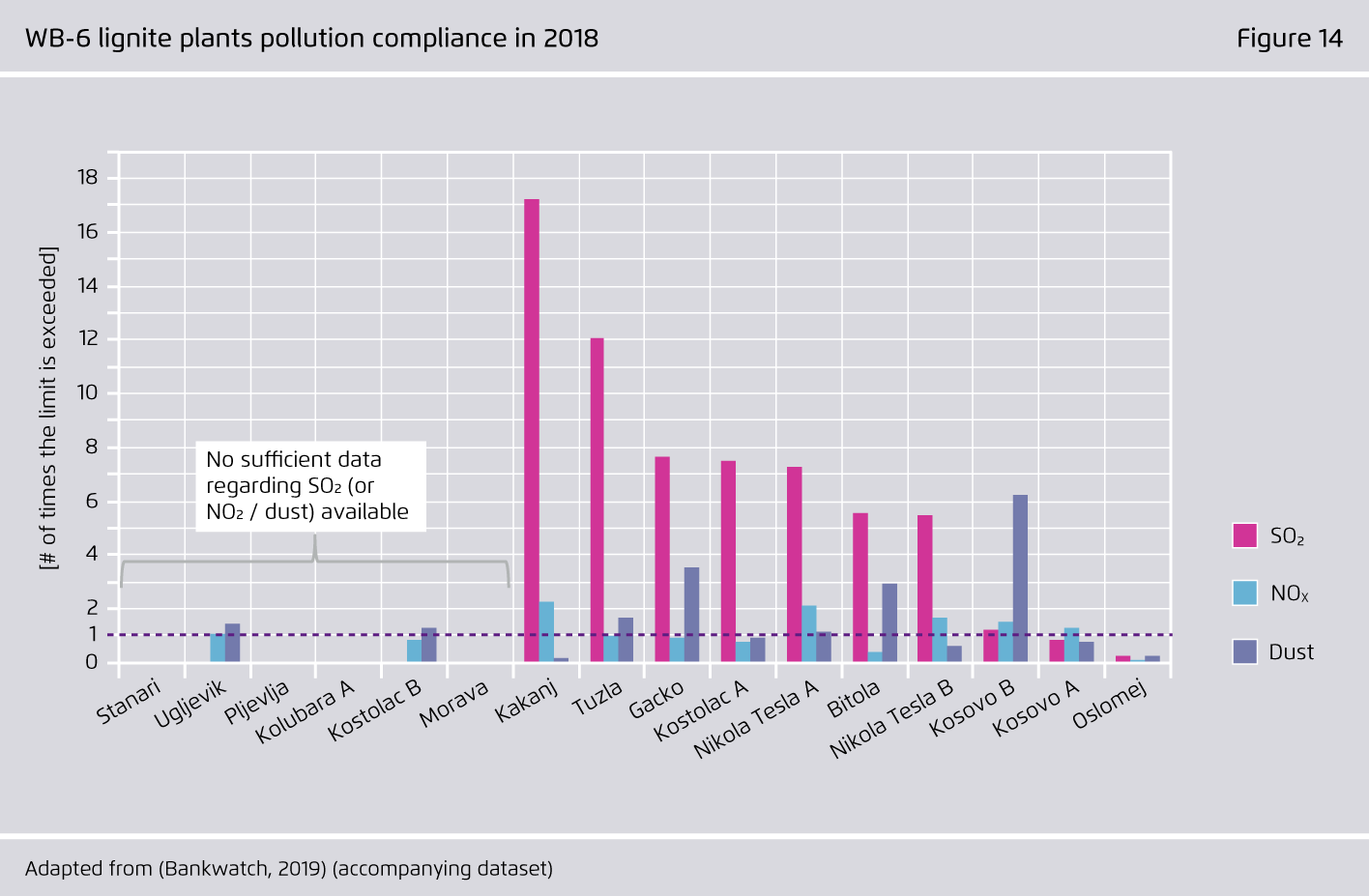
Under consideration of the Creative Commons license CC BY (attribution) the image may be further processed in any format or medium (also commercially, also in modified form), as long as the author is mentioned and a link to the license is given.
Air Pollution Regulation: EU and WB-6
Figure 15 from The future of lignite in the Western Balkans on page 23

Under consideration of the Creative Commons license CC BY (attribution) the image may be further processed in any format or medium (also commercially, also in modified form), as long as the author is mentioned and a link to the license is given.
Timeline of pollution regulation and response options for Energy Community parties
Figure 16 from The future of lignite in the Western Balkans on page 24
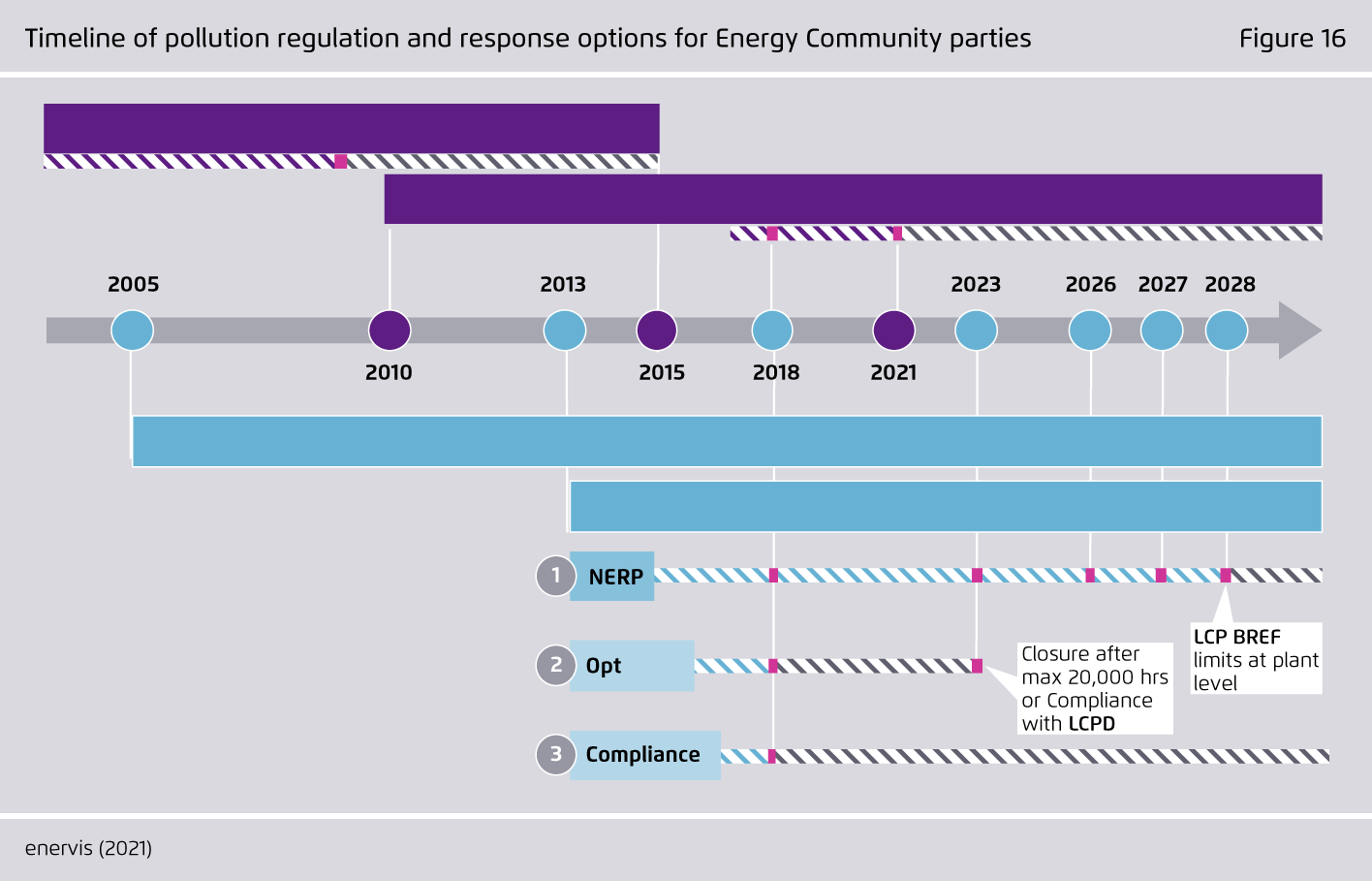
Under consideration of the Creative Commons license CC BY (attribution) the image may be further processed in any format or medium (also commercially, also in modified form), as long as the author is mentioned and a link to the license is given.
Overview of lignite plant capacities by derogation option
Figure 17 from The future of lignite in the Western Balkans on page 25

Under consideration of the Creative Commons license CC BY (attribution) the image may be further processed in any format or medium (also commercially, also in modified form), as long as the author is mentioned and a link to the license is given.
Overview of 2018 lignite output (left) and existing reserves (right) in the region
Figure 18 from The future of lignite in the Western Balkans on page 25

Under consideration of the Creative Commons license CC BY (attribution) the image may be further processed in any format or medium (also commercially, also in modified form), as long as the author is mentioned and a link to the license is given.
Economic performance of lignite mines in the Western Balkan region
Figure 19 from The future of lignite in the Western Balkans on page 26
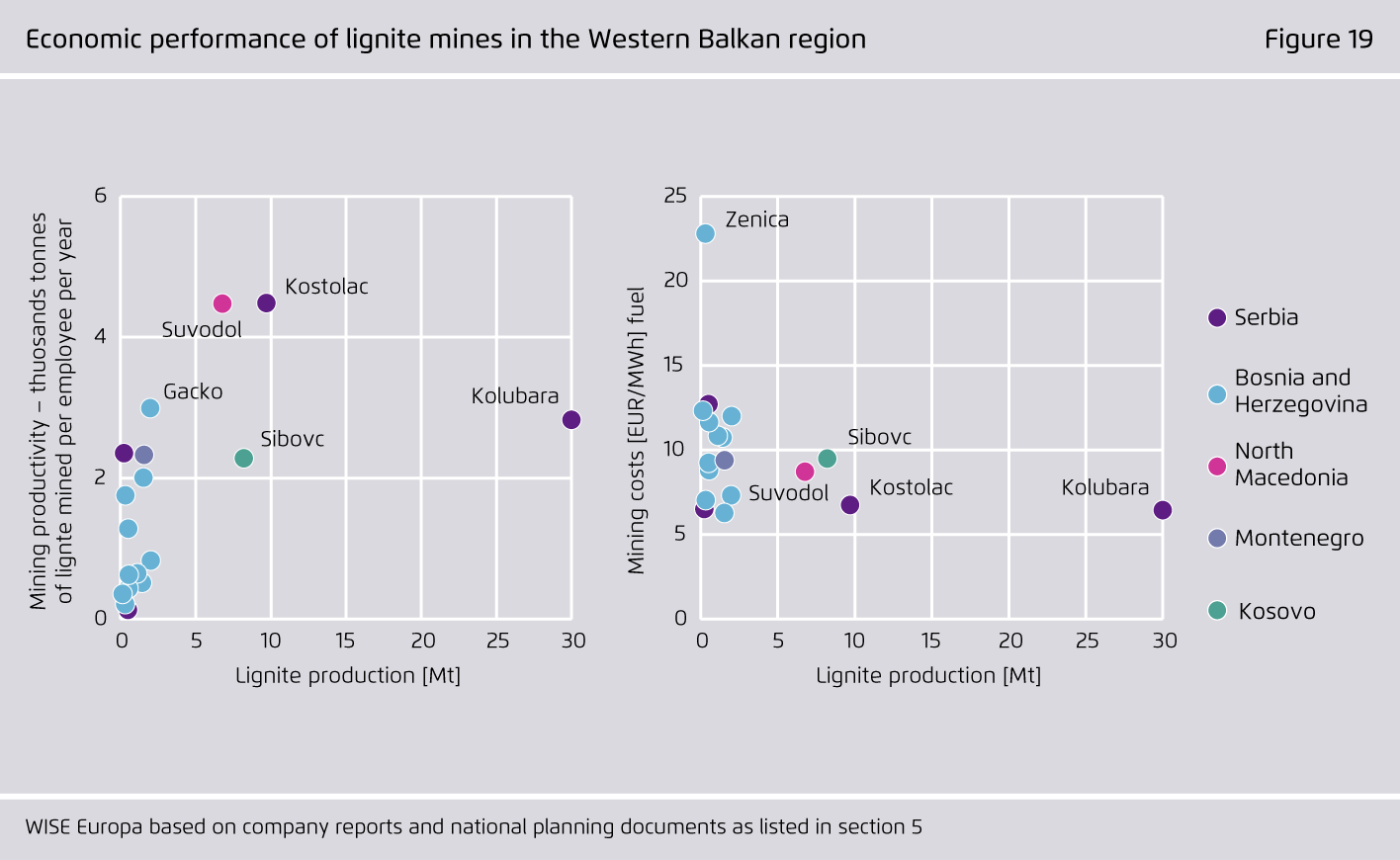
Under consideration of the Creative Commons license CC BY (attribution) the image may be further processed in any format or medium (also commercially, also in modified form), as long as the author is mentioned and a link to the license is given.
Scenario architecture
Figure 20 from The future of lignite in the Western Balkans on page 29

Under consideration of the Creative Commons license CC BY (attribution) the image may be further processed in any format or medium (also commercially, also in modified form), as long as the author is mentioned and a link to the license is given.
Overview of the main assumptions in the modelled power market scenarios
Figure 21 from The future of lignite in the Western Balkans on page 30

Under consideration of the Creative Commons license CC BY (attribution) the image may be further processed in any format or medium (also commercially, also in modified form), as long as the author is mentioned and a link to the license is given.
Approach for developing lignite trajectories in the power market scenarios
Figure 22 from The future of lignite in the Western Balkans on page 31

Under consideration of the Creative Commons license CC BY (attribution) the image may be further processed in any format or medium (also commercially, also in modified form), as long as the author is mentioned and a link to the license is given.
Overview of considered new lignite projects in the region
Figure 23 from The future of lignite in the Western Balkans on page 32

Under consideration of the Creative Commons license CC BY (attribution) the image may be further processed in any format or medium (also commercially, also in modified form), as long as the author is mentioned and a link to the license is given.
Resulting lignite capacity trajectories in the two scenario pathways at the regional level
Figure 24 from The future of lignite in the Western Balkans on page 33

Under consideration of the Creative Commons license CC BY (attribution) the image may be further processed in any format or medium (also commercially, also in modified form), as long as the author is mentioned and a link to the license is given.
Approach for developing renewable trajectories in the power market scenarios
Figure 25 from The future of lignite in the Western Balkans on page 34
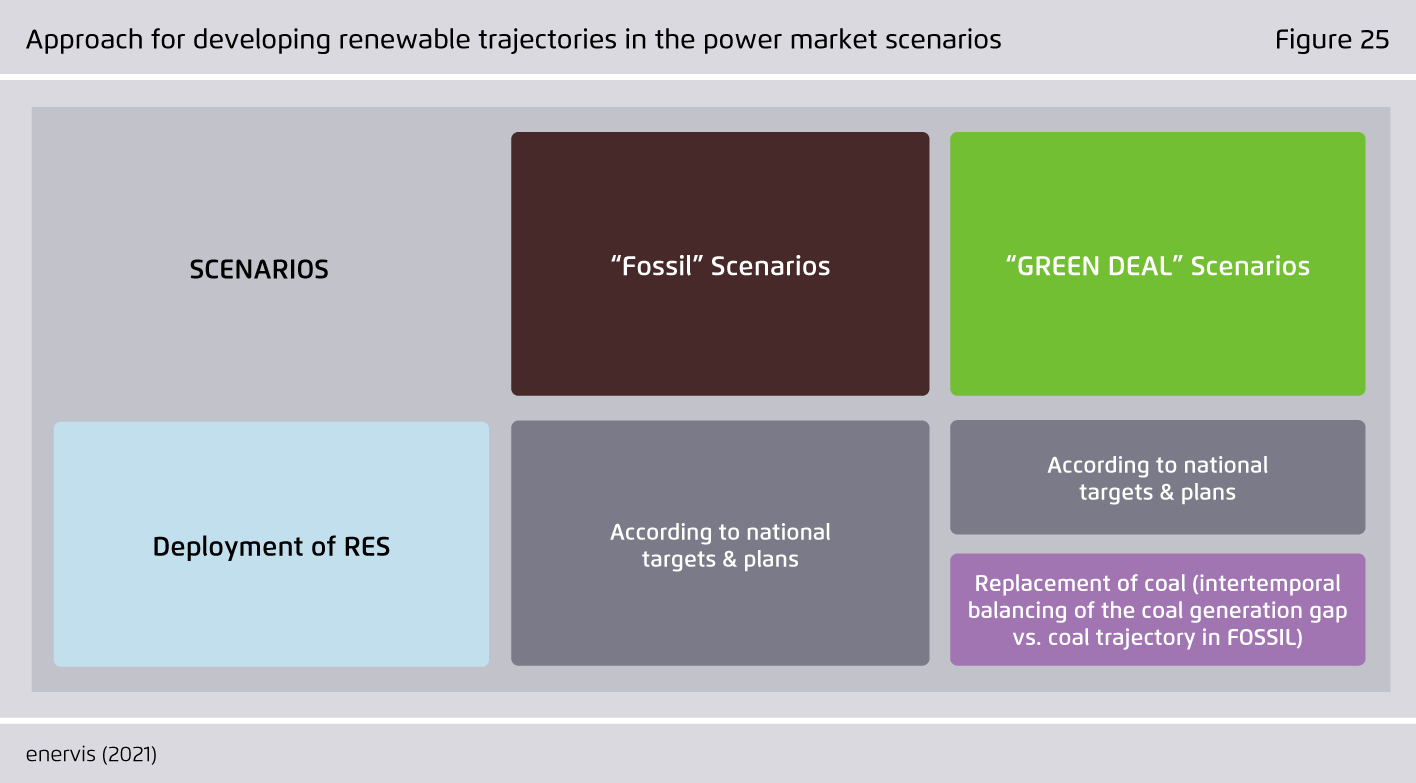
Under consideration of the Creative Commons license CC BY (attribution) the image may be further processed in any format or medium (also commercially, also in modified form), as long as the author is mentioned and a link to the license is given.
Fuel and CO price assumptions in the power market scenarios
Figure 26 from The future of lignite in the Western Balkans on page 35

Under consideration of the Creative Commons license CC BY (attribution) the image may be further processed in any format or medium (also commercially, also in modified form), as long as the author is mentioned and a link to the license is given.
Calculation of the CBA tax in the model for the Fossil CBA scenario
Figure 27 from The future of lignite in the Western Balkans on page 36

Under consideration of the Creative Commons license CC BY (attribution) the image may be further processed in any format or medium (also commercially, also in modified form), as long as the author is mentioned and a link to the license is given.
Country-specific lignite cost assumptions
Figure 28 from The future of lignite in the Western Balkans on page 37

Under consideration of the Creative Commons license CC BY (attribution) the image may be further processed in any format or medium (also commercially, also in modified form), as long as the author is mentioned and a link to the license is given.
The enervis power market model
Figure 29 from The future of lignite in the Western Balkans on page 39

Under consideration of the Creative Commons license CC BY (attribution) the image may be further processed in any format or medium (also commercially, also in modified form), as long as the author is mentioned and a link to the license is given.
Power market outlook for the WB-6 region across the scenarios
Figure 30 from The future of lignite in the Western Balkans on page 42
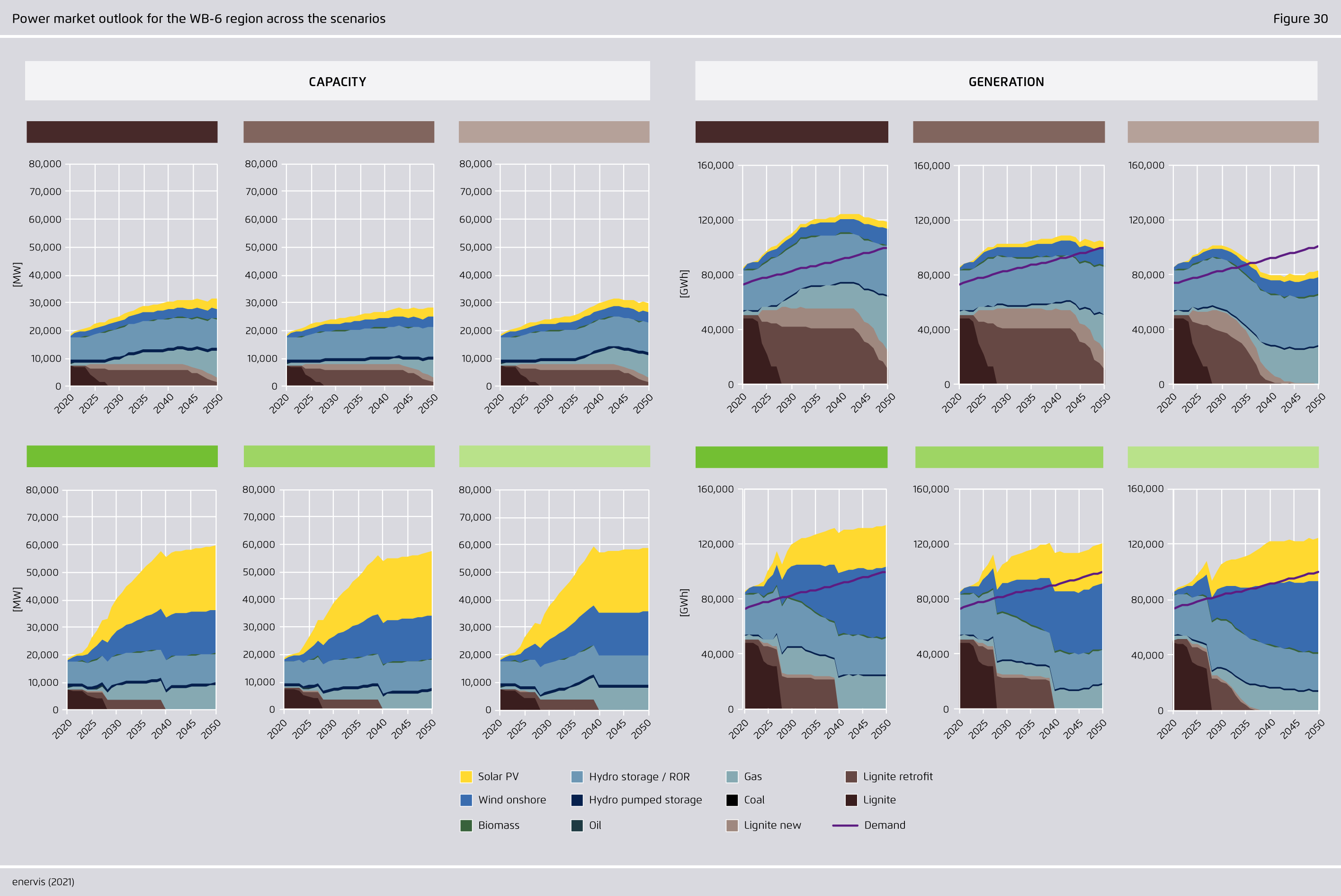
Under consideration of the Creative Commons license CC BY (attribution) the image may be further processed in any format or medium (also commercially, also in modified form), as long as the author is mentioned and a link to the license is given.
Development of capacity for the WB-6 region across the scenarios
Figure 31 from The future of lignite in the Western Balkans on page 44

Under consideration of the Creative Commons license CC BY (attribution) the image may be further processed in any format or medium (also commercially, also in modified form), as long as the author is mentioned and a link to the license is given.
Demand development of RES shares (left) and lignite shares (right) in the WB-6
Figure 32 from The future of lignite in the Western Balkans on page 45
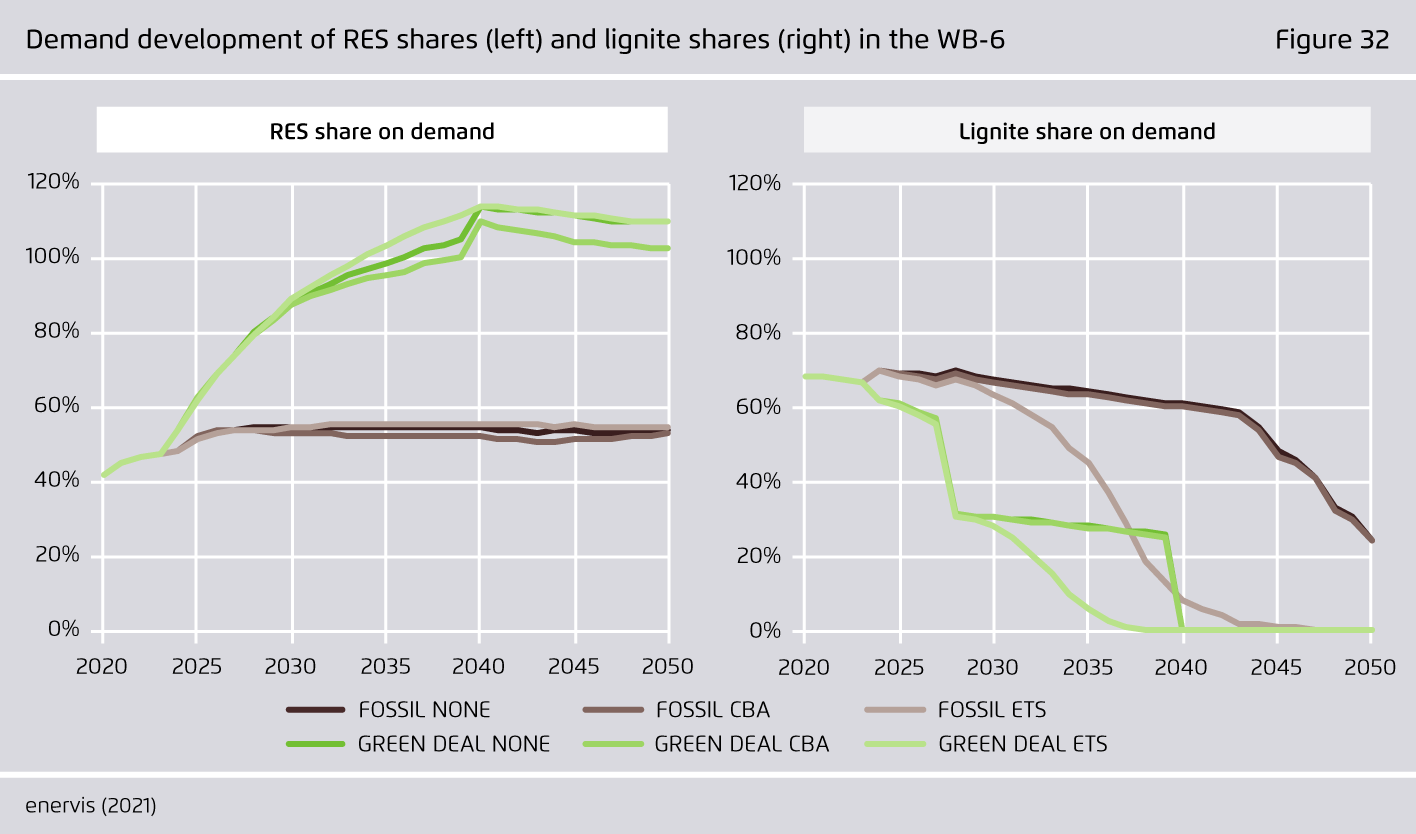
Under consideration of the Creative Commons license CC BY (attribution) the image may be further processed in any format or medium (also commercially, also in modified form), as long as the author is mentioned and a link to the license is given.
Development of annual CO₂ emissions (left) and the cumulated sum 2020–2050 (right)
Figure 33 from The future of lignite in the Western Balkans on page 46

Under consideration of the Creative Commons license CC BY (attribution) the image may be further processed in any format or medium (also commercially, also in modified form), as long as the author is mentioned and a link to the license is given.
Cumulated (2020–2050) incremental generation costs (left) and scenario di fferences (Green Deal minus Fossil) (right) in the WB-6 region
Figure 34 from The future of lignite in the Western Balkans on page 47

Under consideration of the Creative Commons license CC BY (attribution) the image may be further processed in any format or medium (also commercially, also in modified form), as long as the author is mentioned and a link to the license is given.
Main drivers of incremental generation costs for the WB-6 region across the scenarios
Figure 35 from The future of lignite in the Western Balkans on page 48

Under consideration of the Creative Commons license CC BY (attribution) the image may be further processed in any format or medium (also commercially, also in modified form), as long as the author is mentioned and a link to the license is given.
Investment needs for the WB-6 region across the scenarios
Figure 36 from The future of lignite in the Western Balkans on page 49

Under consideration of the Creative Commons license CC BY (attribution) the image may be further processed in any format or medium (also commercially, also in modified form), as long as the author is mentioned and a link to the license is given.
Consumer costs for the WB-6 region across the scenarios
Figure 37 from The future of lignite in the Western Balkans on page 51

Under consideration of the Creative Commons license CC BY (attribution) the image may be further processed in any format or medium (also commercially, also in modified form), as long as the author is mentioned and a link to the license is given.
Development of the power market structure across the scenarios – Bosnia and Herzegovina
Figure 38 from The future of lignite in the Western Balkans on page 52

Under consideration of the Creative Commons license CC BY (attribution) the image may be further processed in any format or medium (also commercially, also in modified form), as long as the author is mentioned and a link to the license is given.
Cumulated incremental generation costs (2020–2050) (left) and scenario di fferences (Green Deal – Fossil) (right) – Bosnia and Herzegovina
Figure 39 from The future of lignite in the Western Balkans on page 54

Under consideration of the Creative Commons license CC BY (attribution) the image may be further processed in any format or medium (also commercially, also in modified form), as long as the author is mentioned and a link to the license is given.
Average wholesale base prices per modelled decade – Bosnia and Herzegovina
Figure 40 from The future of lignite in the Western Balkans on page 55

Under consideration of the Creative Commons license CC BY (attribution) the image may be further processed in any format or medium (also commercially, also in modified form), as long as the author is mentioned and a link to the license is given.
Development of consumer costs across the scenarios – Bosnia and Herzegovina
Figure 41 from The future of lignite in the Western Balkans on page 56
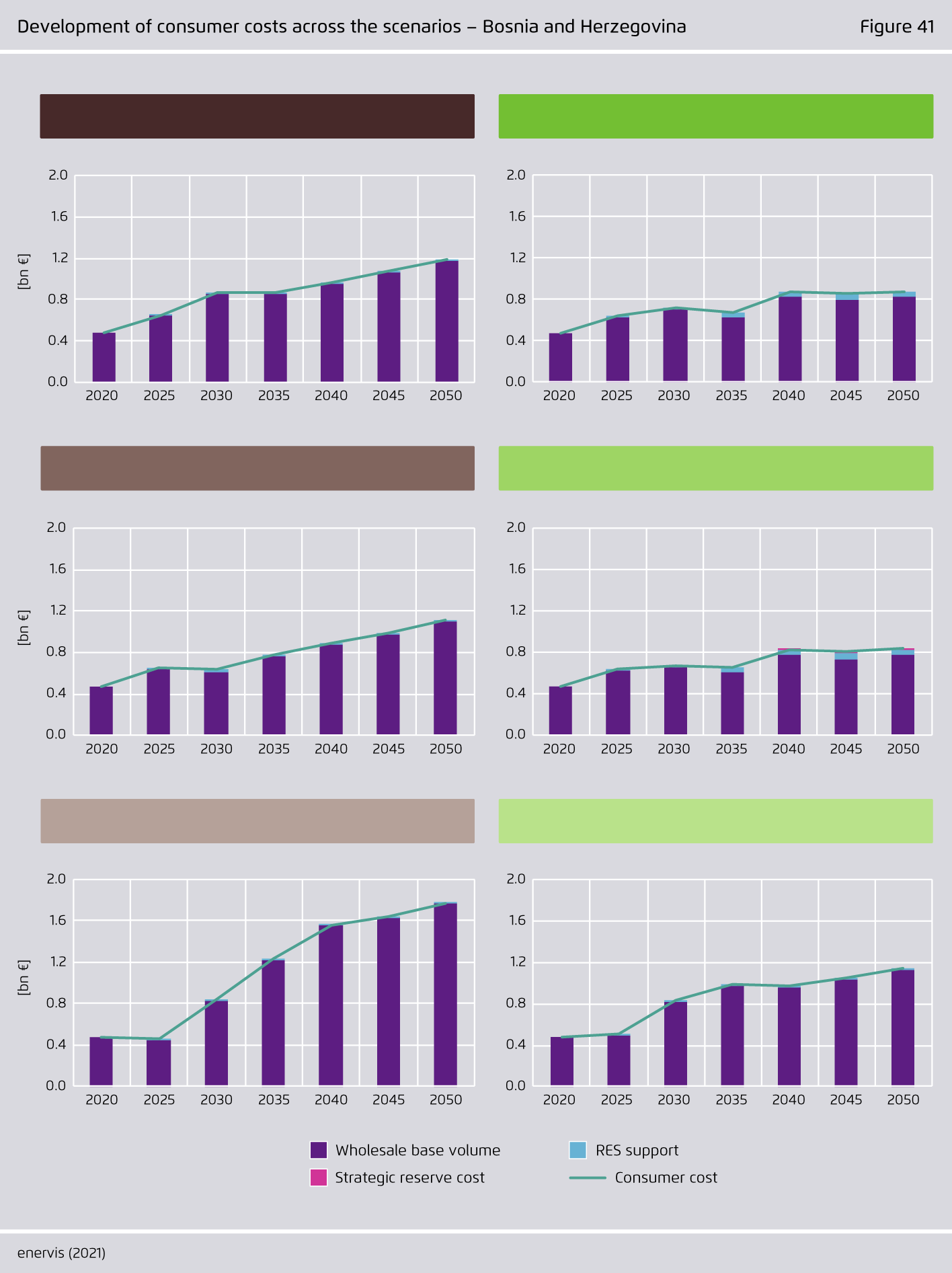
Under consideration of the Creative Commons license CC BY (attribution) the image may be further processed in any format or medium (also commercially, also in modified form), as long as the author is mentioned and a link to the license is given.
Investment needs across the scenarios – Bosnia and Herzegovina
Figure 42 from The future of lignite in the Western Balkans on page 57

Under consideration of the Creative Commons license CC BY (attribution) the image may be further processed in any format or medium (also commercially, also in modified form), as long as the author is mentioned and a link to the license is given.
Annual RES support (lines) vs. RES generation costs (bars) – Bosnia and Herzegovina
Figure 43 from The future of lignite in the Western Balkans on page 58

Under consideration of the Creative Commons license CC BY (attribution) the image may be further processed in any format or medium (also commercially, also in modified form), as long as the author is mentioned and a link to the license is given.
Development of the power market structure across the scenarios – Kosovo
Figure 44 from The future of lignite in the Western Balkans on page 60

Under consideration of the Creative Commons license CC BY (attribution) the image may be further processed in any format or medium (also commercially, also in modified form), as long as the author is mentioned and a link to the license is given.
Cumulated incremental generation costs (2020–2050) (left) and scenario di fferences.(Balkan Green Deal – Fossil) (right) – Kosovo
Figure 45 from The future of lignite in the Western Balkans on page 62

Under consideration of the Creative Commons license CC BY (attribution) the image may be further processed in any format or medium (also commercially, also in modified form), as long as the author is mentioned and a link to the license is given.
Average wholesale base prices per modelled decade – Kosovo
Figure 46 from The future of lignite in the Western Balkans on page 62

Under consideration of the Creative Commons license CC BY (attribution) the image may be further processed in any format or medium (also commercially, also in modified form), as long as the author is mentioned and a link to the license is given.
Development of consumer costs across the scenarios – Kosovo
Figure 47 from The future of lignite in the Western Balkans on page 63

Under consideration of the Creative Commons license CC BY (attribution) the image may be further processed in any format or medium (also commercially, also in modified form), as long as the author is mentioned and a link to the license is given.
Investment needs across the scenarios – Kosovo
Figure 48 from The future of lignite in the Western Balkans on page 64

Under consideration of the Creative Commons license CC BY (attribution) the image may be further processed in any format or medium (also commercially, also in modified form), as long as the author is mentioned and a link to the license is given.
Annual RES support (lines) vs. RES system costs (bars) – Kosovo
Figure 49 from The future of lignite in the Western Balkans on page 65

Under consideration of the Creative Commons license CC BY (attribution) the image may be further processed in any format or medium (also commercially, also in modified form), as long as the author is mentioned and a link to the license is given.
Development of the power market structure across the scenarios – Serbia
Figure 50 from The future of lignite in the Western Balkans on page 66

Under consideration of the Creative Commons license CC BY (attribution) the image may be further processed in any format or medium (also commercially, also in modified form), as long as the author is mentioned and a link to the license is given.
Cumulated incremental generation costs (2020–2050) (left) and scenario di fferences (Green Deal – Fossil) (right) – Serbia
Figure 51 from The future of lignite in the Western Balkans on page 68

Under consideration of the Creative Commons license CC BY (attribution) the image may be further processed in any format or medium (also commercially, also in modified form), as long as the author is mentioned and a link to the license is given.
Average wholesale base prices per modelled decade – Serbia
Figure 52 from The future of lignite in the Western Balkans on page 69

Under consideration of the Creative Commons license CC BY (attribution) the image may be further processed in any format or medium (also commercially, also in modified form), as long as the author is mentioned and a link to the license is given.
Development of consumer costs across the scenarios – Serbia
Figure 53 from The future of lignite in the Western Balkans on page 70

Under consideration of the Creative Commons license CC BY (attribution) the image may be further processed in any format or medium (also commercially, also in modified form), as long as the author is mentioned and a link to the license is given.
Investment needs across the scenarios – Serbia
Figure 54 from The future of lignite in the Western Balkans on page 71

Under consideration of the Creative Commons license CC BY (attribution) the image may be further processed in any format or medium (also commercially, also in modified form), as long as the author is mentioned and a link to the license is given.
Annual RES support (lines) vs. RES system costs (bars)
Figure 55 from The future of lignite in the Western Balkans on page 72
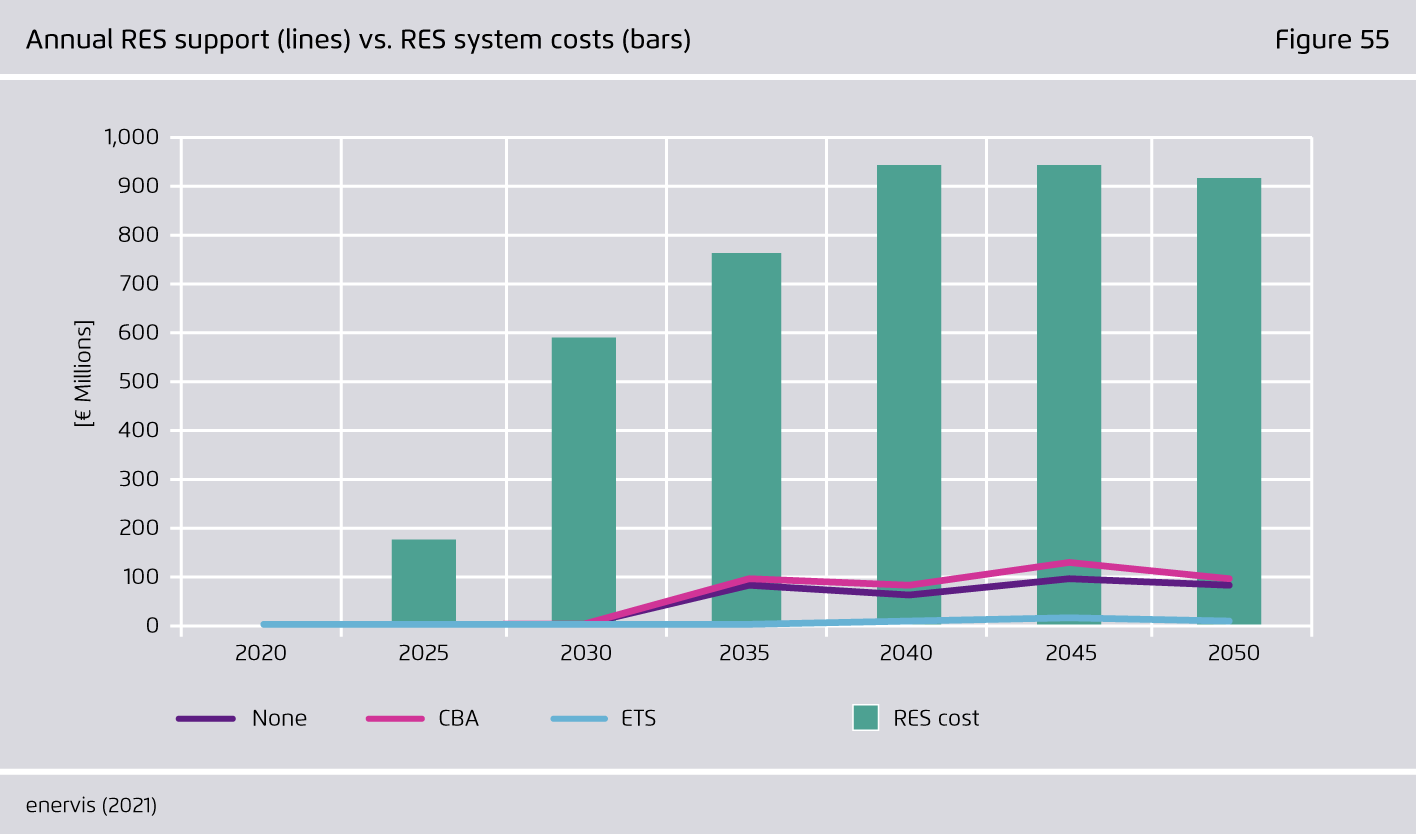
Under consideration of the Creative Commons license CC BY (attribution) the image may be further processed in any format or medium (also commercially, also in modified form), as long as the author is mentioned and a link to the license is given.
Calculated net present values for proposed lignite projects in the region
Figure 56 from The future of lignite in the Western Balkans on page 73

Under consideration of the Creative Commons license CC BY (attribution) the image may be further processed in any format or medium (also commercially, also in modified form), as long as the author is mentioned and a link to the license is given.
Development of capacity across the scenarios – Bosnia and Herzegovina
Figure 57 from The future of lignite in the Western Balkans on page 80

Under consideration of the Creative Commons license CC BY (attribution) the image may be further processed in any format or medium (also commercially, also in modified form), as long as the author is mentioned and a link to the license is given.
Development of RES shares (left) and lignite shares (right) in demand – Bosnia and Herzegovina
Figure 58 from The future of lignite in the Western Balkans on page 81
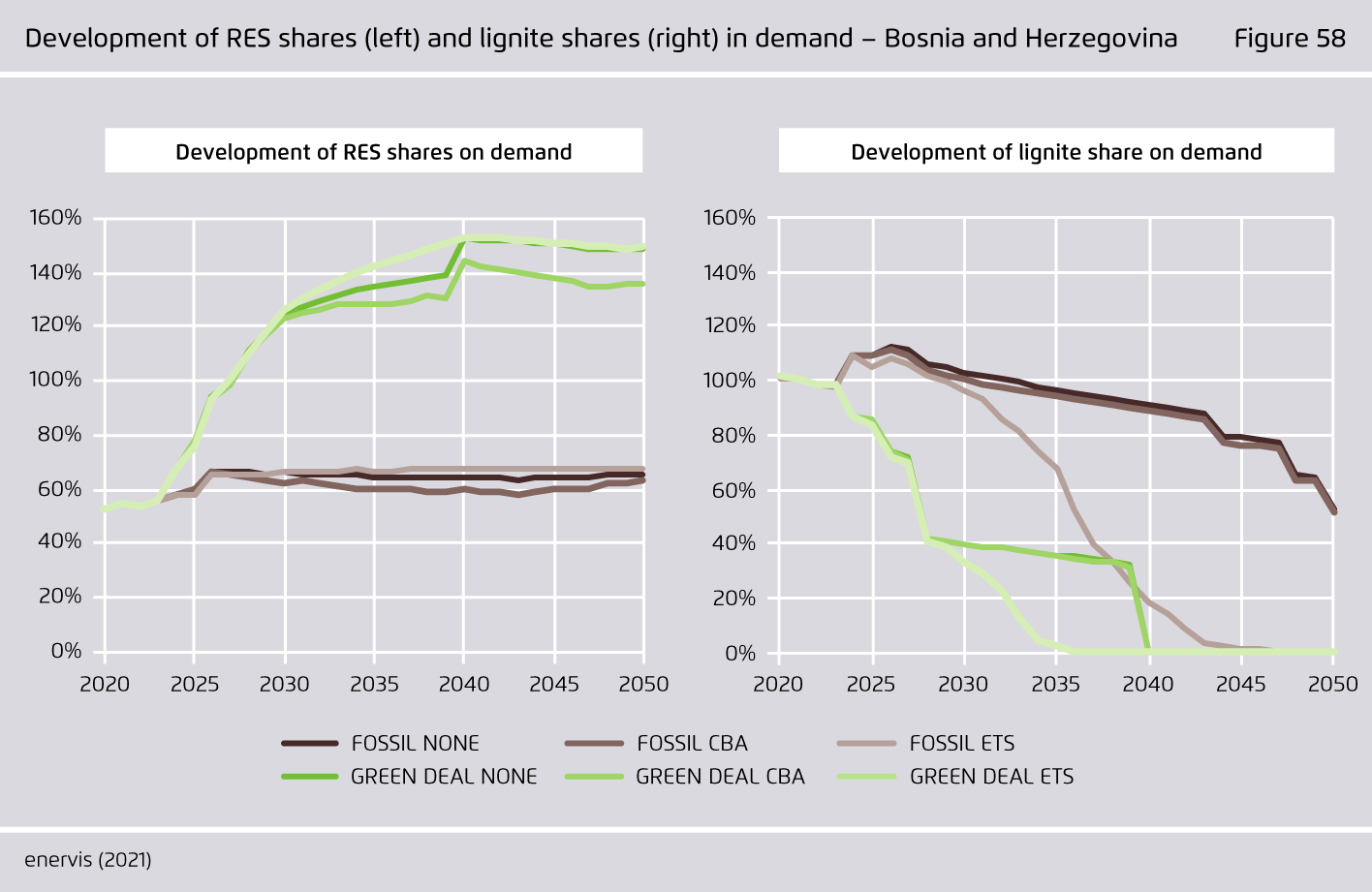
Under consideration of the Creative Commons license CC BY (attribution) the image may be further processed in any format or medium (also commercially, also in modified form), as long as the author is mentioned and a link to the license is given.
Development of CO₂ emissions – Bosnia and Herzegovina
Figure 59 from The future of lignite in the Western Balkans on page 81

Under consideration of the Creative Commons license CC BY (attribution) the image may be further processed in any format or medium (also commercially, also in modified form), as long as the author is mentioned and a link to the license is given.
Development of capacity across the scenarios – Kosovo
Figure 60 from The future of lignite in the Western Balkans on page 83

Under consideration of the Creative Commons license CC BY (attribution) the image may be further processed in any format or medium (also commercially, also in modified form), as long as the author is mentioned and a link to the license is given.
Development of RES shares (left) and lignite shares (right) in demand – Kosovo
Figure 61 from The future of lignite in the Western Balkans on page 84

Under consideration of the Creative Commons license CC BY (attribution) the image may be further processed in any format or medium (also commercially, also in modified form), as long as the author is mentioned and a link to the license is given.
Development of CO₂ emissions – Kosovo
Figure 62 from The future of lignite in the Western Balkans on page 84

Under consideration of the Creative Commons license CC BY (attribution) the image may be further processed in any format or medium (also commercially, also in modified form), as long as the author is mentioned and a link to the license is given.
Development of capacity across the scenarios – Serbia
Figure 63 from The future of lignite in the Western Balkans on page 86

Under consideration of the Creative Commons license CC BY (attribution) the image may be further processed in any format or medium (also commercially, also in modified form), as long as the author is mentioned and a link to the license is given.
Development of RES shares (left) and lignite shares (right) in demand – Serbia
Figure 64 from The future of lignite in the Western Balkans on page 87
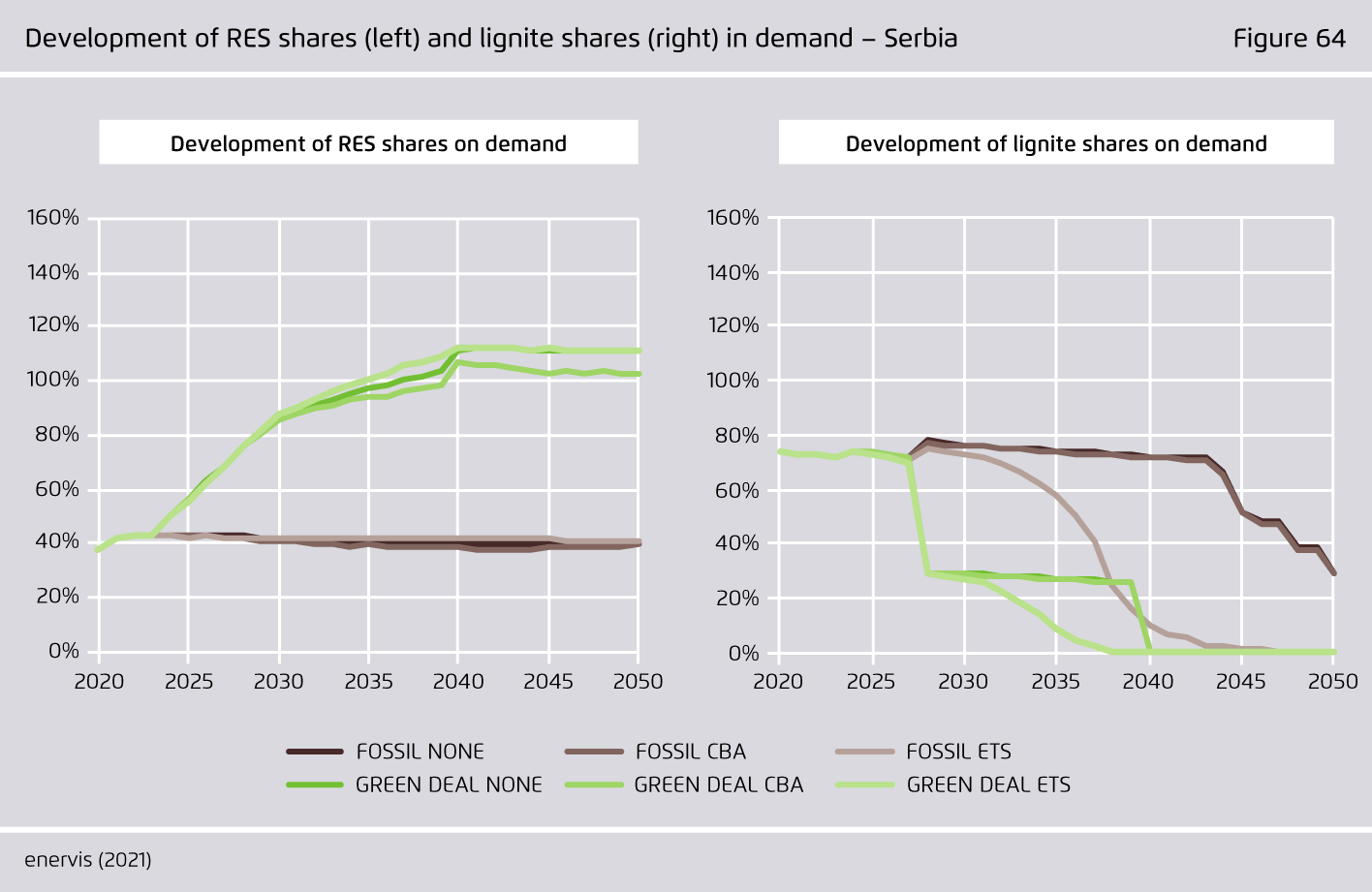
Under consideration of the Creative Commons license CC BY (attribution) the image may be further processed in any format or medium (also commercially, also in modified form), as long as the author is mentioned and a link to the license is given.
Development of CO₂ emissions – Serbia
Figure 65 from The future of lignite in the Western Balkans on page 87

Under consideration of the Creative Commons license CC BY (attribution) the image may be further processed in any format or medium (also commercially, also in modified form), as long as the author is mentioned and a link to the license is given.
Capacity balancing approach (schematic)
Figure 66 from The future of lignite in the Western Balkans on page 89

Under consideration of the Creative Commons license CC BY (attribution) the image may be further processed in any format or medium (also commercially, also in modified form), as long as the author is mentioned and a link to the license is given.
Development of strategic reserve needs
Figure 67 from The future of lignite in the Western Balkans on page 91

Under consideration of the Creative Commons license CC BY (attribution) the image may be further processed in any format or medium (also commercially, also in modified form), as long as the author is mentioned and a link to the license is given.
Investment needs for strategic reserves
Figure 68 from The future of lignite in the Western Balkans on page 92

Under consideration of the Creative Commons license CC BY (attribution) the image may be further processed in any format or medium (also commercially, also in modified form), as long as the author is mentioned and a link to the license is given.
Power capacity and generation mix for 2014–2018 in Bosnia and Herzegovina
Figure 69 from The future of lignite in the Western Balkans on page 93

Under consideration of the Creative Commons license CC BY (attribution) the image may be further processed in any format or medium (also commercially, also in modified form), as long as the author is mentioned and a link to the license is given.
Imports, exports and trade balance for 2014–2018 in Bosnia and Herzegovina
Figure 70 from The future of lignite in the Western Balkans on page 93

Under consideration of the Creative Commons license CC BY (attribution) the image may be further processed in any format or medium (also commercially, also in modified form), as long as the author is mentioned and a link to the license is given.
Power capacity and generation mix 2014–2018 in Kosovo
Figure 71 from The future of lignite in the Western Balkans on page 94

Under consideration of the Creative Commons license CC BY (attribution) the image may be further processed in any format or medium (also commercially, also in modified form), as long as the author is mentioned and a link to the license is given.
Imports, exports and trade balance for 2014–2018 in Kosovo
Figure 72 from The future of lignite in the Western Balkans on page 94

Under consideration of the Creative Commons license CC BY (attribution) the image may be further processed in any format or medium (also commercially, also in modified form), as long as the author is mentioned and a link to the license is given.
Power capacity and generation mix for 2014–2018 in Serbia
Figure 73 from The future of lignite in the Western Balkans on page 95

Under consideration of the Creative Commons license CC BY (attribution) the image may be further processed in any format or medium (also commercially, also in modified form), as long as the author is mentioned and a link to the license is given.
Imports, exports and trade balance for 2014–2018 in Serbia
Figure 74 from The future of lignite in the Western Balkans on page 95

Under consideration of the Creative Commons license CC BY (attribution) the image may be further processed in any format or medium (also commercially, also in modified form), as long as the author is mentioned and a link to the license is given.
Power capacity and generation mix for 2014–2018 in Albania
Figure 75 from The future of lignite in the Western Balkans on page 96

Under consideration of the Creative Commons license CC BY (attribution) the image may be further processed in any format or medium (also commercially, also in modified form), as long as the author is mentioned and a link to the license is given.
Imports, exports and trade balance for 2014–2018 in Albania
Figure 76 from The future of lignite in the Western Balkans on page 96

Under consideration of the Creative Commons license CC BY (attribution) the image may be further processed in any format or medium (also commercially, also in modified form), as long as the author is mentioned and a link to the license is given.
Power capacity and generation mix for 2014–2018 in Montenegro
Figure 77 from The future of lignite in the Western Balkans on page 97
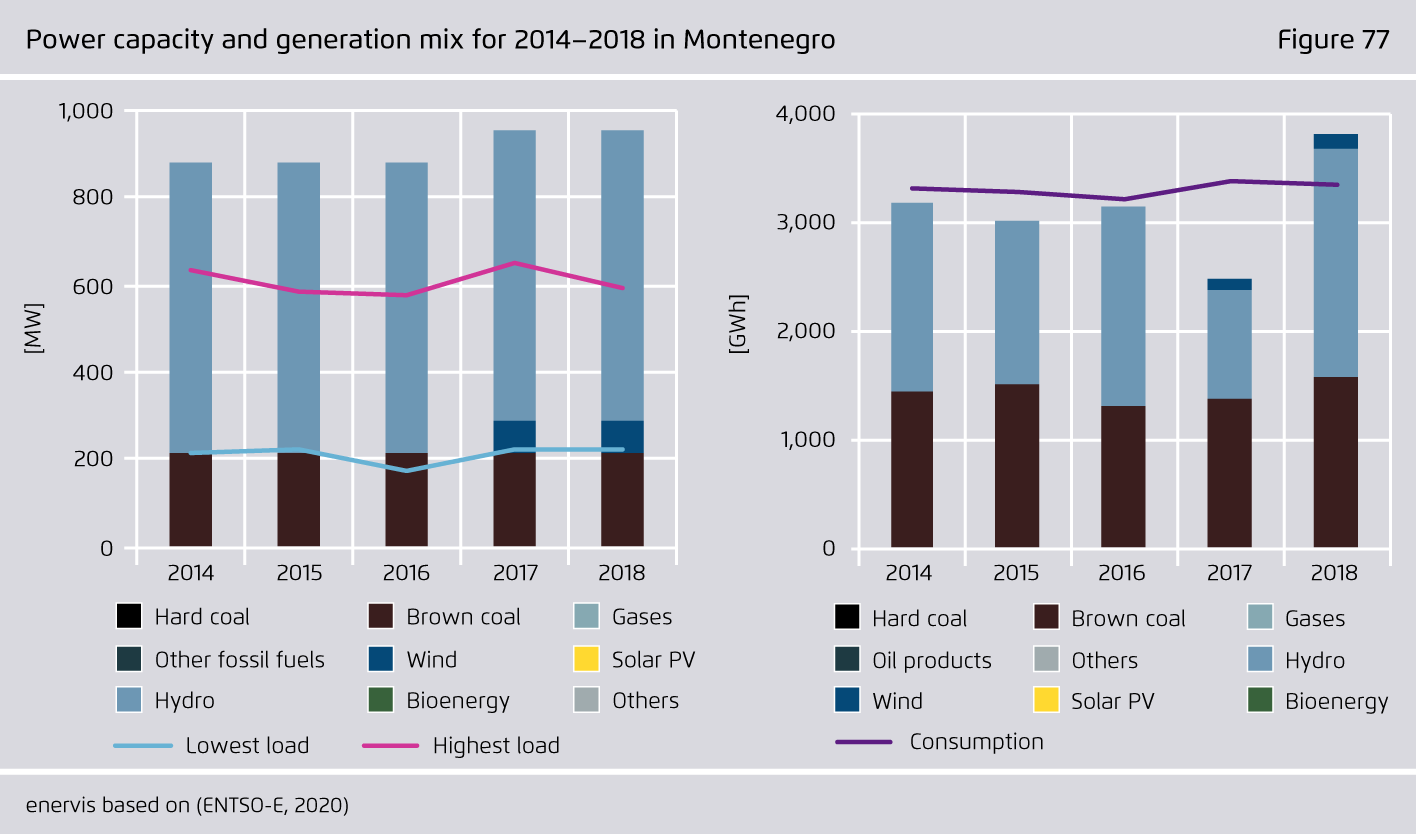
Under consideration of the Creative Commons license CC BY (attribution) the image may be further processed in any format or medium (also commercially, also in modified form), as long as the author is mentioned and a link to the license is given.
Imports, exports and trade balance for 2014–2018 in Montenegro
Figure 78 from The future of lignite in the Western Balkans on page 97

Under consideration of the Creative Commons license CC BY (attribution) the image may be further processed in any format or medium (also commercially, also in modified form), as long as the author is mentioned and a link to the license is given.
Power capacity and generation mix for 2014–2018 in North Macedonia
Figure 79 from The future of lignite in the Western Balkans on page 98
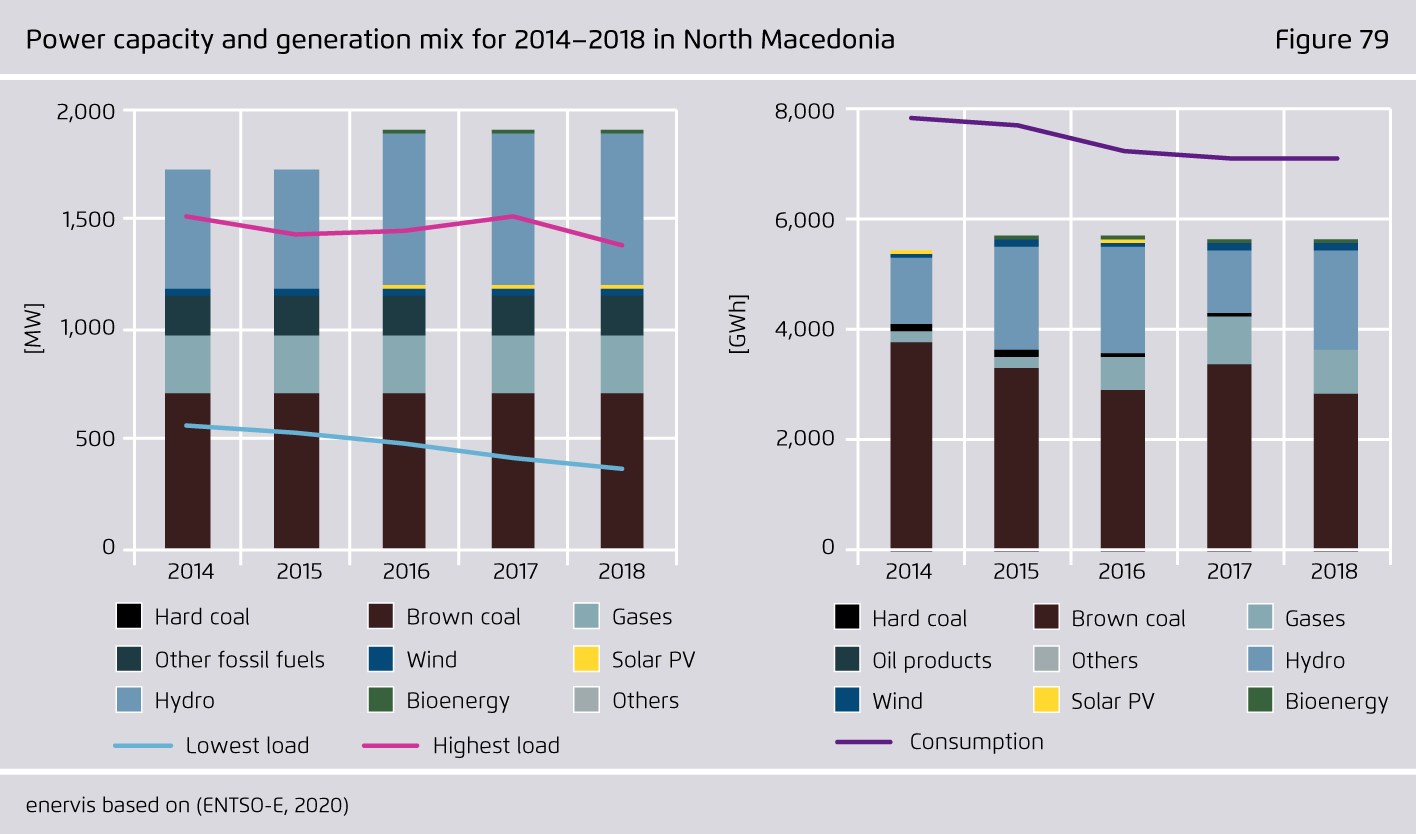
Under consideration of the Creative Commons license CC BY (attribution) the image may be further processed in any format or medium (also commercially, also in modified form), as long as the author is mentioned and a link to the license is given.
Imports, exports and trade balance for 2014–2018 North Macedonia
Figure 80 from The future of lignite in the Western Balkans on page 98
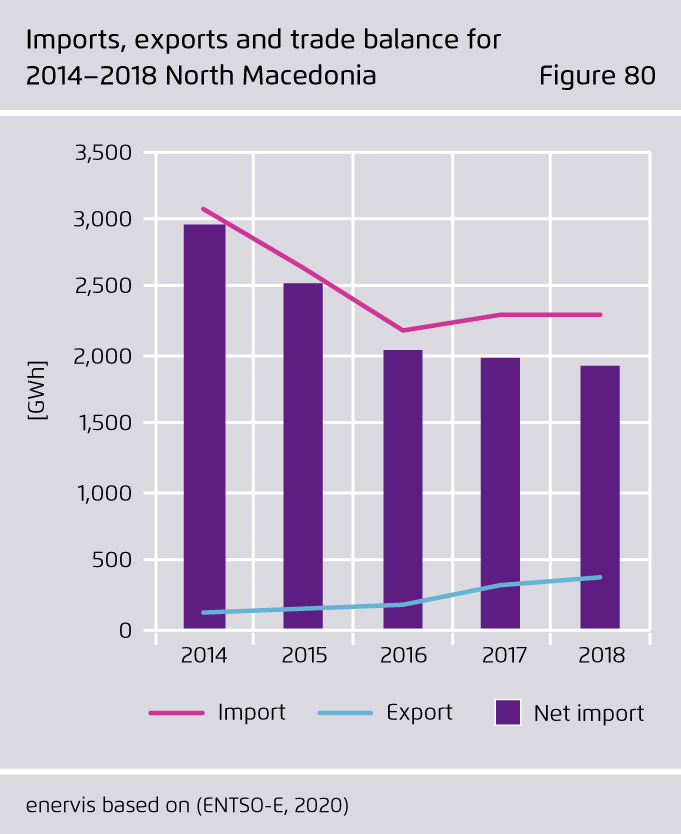
Under consideration of the Creative Commons license CC BY (attribution) the image may be further processed in any format or medium (also commercially, also in modified form), as long as the author is mentioned and a link to the license is given.



